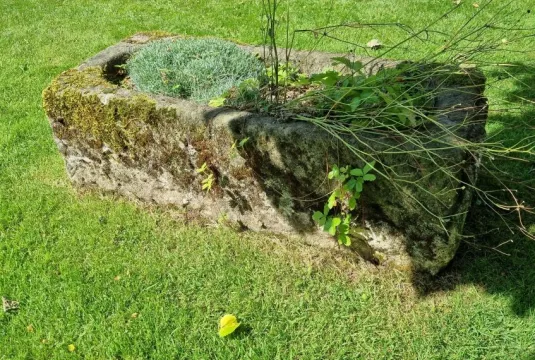The Lost Derbshire Traditional Skills of Stone Masonry:
The Creation of Stone Troughs

Stone troughs, once a common sight in the agricultural landscapes of Derbyshire and the Peak District, serve as a testament to the region's rich heritage of stone masonry. These functional yet elegantly crafted objects were essential for providing water and feed for livestock, and their creation reflects the ingenuity and artistry of local stone masons.
Selecting the Stone
The first step in creating a stone trough is selecting the appropriate type of stone. In Derbyshire, gritstone and limestone were commonly used due to their abundance and desirable properties. Gritstone, with its coarse texture and durability, was ideal for troughs that needed to withstand harsh weather and heavy use. Limestone, on the other hand, was favored for its relative softness, which made it easier to work with while still being robust enough for practical purposes.
Quarrying
Quarrying the stone involved extracting large blocks from the earth. Traditional methods included the use of hammers, chisels, and wedges to split the stone along its natural grain. This process required a deep understanding of the stone's properties to ensure clean breaks and avoid unnecessary waste. The quarried blocks were then transported to the mason's workshop, where the shaping process began.
Shaping the Stone
Shaping the stone block into a trough involved several stages. Initially, the mason would use a pitching tool to trim away excess material and create a rough rectangular shape. This stage required precision to ensure the block was proportionate and suitable for further refinement. Following this, the mason would use a point chisel and mallet to refine the shape, carefully crafting the trough's exterior to the desired dimensions.
Hollowing Out
The most labor-intensive part of creating a stone trough was hollowing out the interior. Masons used a combination of point chisels, mallets, and sometimes drills to chip away the stone, gradually creating a basin. This process demanded patience and skill to ensure the walls of the trough were of even thickness and the base was level, preventing water from seeping out. The mason had to be meticulous to avoid cracks or flaws that could compromise the trough's integrity.
Finishing Touches
Once the trough was hollowed out, the final stage involved smoothing and finishing the surface. Masons used finer chisels and abrasive materials to polish the stone, removing rough edges and creating a more refined appearance. In some cases, decorative elements such as inscriptions or carved motifs were added, showcasing the mason's artistry and often personalizing the trough for its intended owner.
Practical and Historical Significance
Stone troughs were vital to the agricultural practices of Derbyshire and the Peak District, providing a reliable source of water and feed for livestock. Their design had to be practical, ensuring durability and ease of use. However, these troughs also hold historical significance as they reflect the region's rich tradition of stone masonry and the evolution of craftsmanship over the centuries.
Many of the surviving stone troughs today are cherished as historical artifacts. They offer a glimpse into the past, illustrating the daily lives of farmers and the ingenuity required to thrive in a rural environment. The craftsmanship involved in their creation is a testament to the skill and knowledge of the masons who produced them.
Preservation and Legacy
Efforts to preserve these stone troughs are important in maintaining the cultural heritage of Derbyshire and the Peak District. Many troughs have been restored and repurposed as garden ornaments or decorative features, ensuring their continued appreciation. Organizations and local communities play a crucial role in preserving these historical artifacts, recognizing their value as part of the region's architectural and agricultural history.